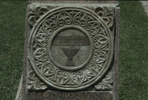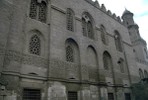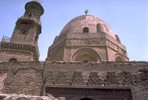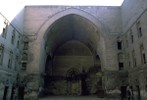Previous Lecture | Next Lecture
Concepts
The Mamluks: From the Arabic mamluk, "owned one" or slave, the Mamluks were imported slaves, mostly of Turkish or Caucasian stock, who were destined for a military career: a curious phenomenon that is not encountered outside the Islamic world. The Mamluks of al-Salih Najm al-Din Ayyub took over after the death of their master and ruled Egypt and Syria form 1250-1517.
Bahri Mamluk: The name given to the first period of Mamluk rule (1250-1382) when Turkish sultans ruled. The word Bahri refers to the regiment whose members were housed in the Roda Citadel in an island in the Nile, called bahr (sea) in Egypt.
Rank: Persian for color, hue, or dye, the word was used in Mamluk Egypt and Syria to designate the emblems and insignia of amirs and sultans. Ranks may be monochromatic or multicolored, free-standing or enclosed in round, pointed, or polygonal shields. They were carved on buildings, painted on glass, wood, and pottery, engraved on metalwork, struck on coins, and embroidered or dyed on textiles.
The Mosque of Sultan al-Zahir Baybars: (1267-69) First royal Mamluk mosque in Cairo. Hypostyle in plan, and fortress-like in elevation, the mosque with its three portals originally stood alone in a quarter north of the walled city. The mosque displays local and Seljuq influences in its spatial arrangement and its surface articulation.
The Complex of Sultan Qalawun: (1284-85) Built on the site of the Western Fatimid Palace opposite the madrasas of al-Salih najm al-Din Ayyub, this complex contains a bimaristan, a madrasa, and a dome/mausoleum for the founder. The street façade is well articulated and shows the confluence of Syrian (Crusader and Islamic) arrangements. The madrasa is a four-iwan type with a basilical organization in the qibla iwan. The Dome of the mausoleum echoes the octagonal plan of the Dome of the Rock.
The Khanqah of Sultan Baybars al-Jashankir: (1307-10) A structure with a biaxial plan, this khanqah had a mausoleum added on its qibla side. It contains roomsfor the sufis aligned on its two longitudinal sides.
Monuments








